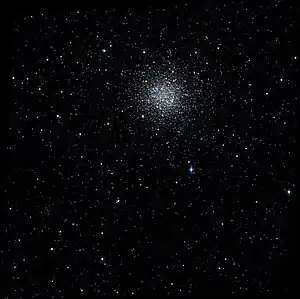| NGC 416 | |
|---|---|
 NGC 416 by Hubble Space Telescope | |
| Observation data (J2000 epoch) | |
| Right ascension | 01h 07m 58.5s[1] |
| Declination | −72° 21′ 18″[1] |
| Distance | 199,000 ± 9,800 ly (61,000 ± 3,000 pc)[1] |
| Apparent magnitude (V) | 11.42[2] |
| Apparent dimensions (V) | 1.2′ × 1.2′[3] |
| Physical characteristics | |
| Mass | 8.0×104[2] M☉ |
| Estimated age | 6.60±0.80 Gyr[2] |
| Other designations | ESO 029-SC 032.[1] |
| Associations | |
| Constellation | Tucana |
NGC 416 is a globular cluster located in the constellation Tucana. It was discovered on September 5, 1826, by James Dunlop. It was described by Dreyer as "faint, pretty small, round, gradually brighter middle".[3] At a distance of about 199,000 ± 9,800 ly (61,000 ± 3,000 pc), it is located within the Small Magellanic Cloud.[3] At an aperture of 31 arcseconds, its apparent V-band magnitude is 11.42, but at this wavelength, it has 0.25 magnitudes of interstellar extinction.[2]
NGC 416 is about 6.6 billion years old. Its estimated mass is 8.0×104 M☉, and its total luminosity is 1.12×105 L☉, leading to a mass-to-luminosity ratio of 0.72 M☉/L☉.[2] All else equal, older star clusters have higher mass-to-luminosity ratios; that is, they have lower luminosities for the same mass.[2]
References
- 1 2 3 4 "NASA/IPAC Extragalactic Database". Results for NGC 0416. Retrieved September 2, 2016.
- 1 2 3 4 5 6 Song, Ying-Yi; Mateo, Mario; Bailey, John I.; Walker, Matthew G.; Roederer, Ian U.; Olszewski, Edward W.; Reiter, Megan; Kremin, Anthony (2021). "Dynamical masses and mass-to-light ratios of resolved massive star clusters – II. Results for 26 star clusters in the Magellanic Clouds". Monthly Notices of the Royal Astronomical Society. 504 (3): 4160–4191. arXiv:2104.06882. doi:10.1093/mnras/stab1065.
- 1 2 3 "New General Catalog Objects: NGC 400 - 449". Cseligman. Retrieved February 11, 2017.
External links
 Media related to NGC 416 at Wikimedia Commons
Media related to NGC 416 at Wikimedia Commons